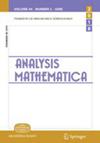$$\mathbb{R}^2$$中具有连续共线位数的自参量的非谱问题
IF 0.5
3区 数学
Q3 MATHEMATICS
引用次数: 0
摘要
让 \(\mu_{M,D}\)是由扩展整数矩阵 \(M\in M_2(\mathbb{Z})\) 和整数数位集 \(D=\{0、v),其中(gcd(\det(M),q)=1)和(qge 2)是整数。如果\(M\)的特征多项式是\(f(x)=x^2+\det(M)\)并且\({v, Mv\}) 是线性独立的,我们证明在\(L^2(\mu_{M,D})\)中最多存在\(q^2\)个相互正交的指数函数,并且数\(q^2\)是最好的。特别是,我们进一步给出了具有 \(\gcd(st, q)=1\) 的情况下 \(M= {\rm diag}(s, t)\的完整描述。)这扩展了 Wei 和 Zhang [24] 的结果。本文章由计算机程序翻译,如有差异,请以英文原文为准。
Non-spectral problem of self-affine measures with consecutive collinear digits in \(\mathbb{R}^2\)
Let \(\mu_{M,D}\) be the planar self-affine measure generated by an expanding integer matrix \(M\in M_2(\mathbb{Z})\) and an integer digit set \(D=\{0,1,\dots,q-1\}v\) with \(v\in\mathbb{Z}^2\setminus\{0\}\), where \(\gcd(\det(M),q)=1\) and \(q\ge 2\) is an integer. If the characteristic polynomial of \(M\) is \(f(x)=x^2+\det(M)\) and \(\{v, Mv\}\) is linearly independent, we show that there exist at most \(q^2\) mutually orthogonal exponential functions in \(L^2(\mu_{M,D})\), and the number \(q^2\) is the best. In particular, we further give a complete description for the case \(M= {\rm diag}(s, t)\) with \(\gcd(st, q)=1\). This extends the results of Wei and Zhang [24].
求助全文
通过发布文献求助,成功后即可免费获取论文全文。
去求助
来源期刊

Analysis Mathematica
MATHEMATICS-
CiteScore
1.00
自引率
14.30%
发文量
54
审稿时长
>12 weeks
期刊介绍:
Traditionally the emphasis of Analysis Mathematica is classical analysis, including real functions (MSC 2010: 26xx), measure and integration (28xx), functions of a complex variable (30xx), special functions (33xx), sequences, series, summability (40xx), approximations and expansions (41xx).
The scope also includes potential theory (31xx), several complex variables and analytic spaces (32xx), harmonic analysis on Euclidean spaces (42xx), abstract harmonic analysis (43xx).
The journal willingly considers papers in difference and functional equations (39xx), functional analysis (46xx), operator theory (47xx), analysis on topological groups and metric spaces, matrix analysis, discrete versions of topics in analysis, convex and geometric analysis and the interplay between geometry and analysis.
 求助内容:
求助内容: 应助结果提醒方式:
应助结果提醒方式:


